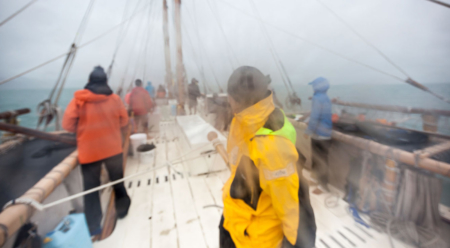In Their Wake: A Journey From Tahiti to Hawai‘i
Life on the deck of Hokule’a, the double-hulled canoe that sails around the world using only ancient wayfinding techniques.
I wipe tears from my cheek just as an electrical charge pulses through my body. My eyes are immediately drawn to a blue streak of light that flashes between my bicep and forearm. I let go of the mast cleat and exchange puzzled glances with fellow crewmembers. An ear-piercing clap of thunder roars overhead. The next bolt of lightning sets fire to Tahuareva, the regal mountain peak we stood upon just days ago.
As we exit the lagoon, the gray smoke from the fire becomes indistinguishable from the dark clouds hovering above the flames. The village of Tautira, Hōkūle‘a’s home in Tahiti, fades into the distance. Flashes of lightning illuminate the dim horizon, revealing an endless line of squalls ahead. Between the driving rain and crashing waves, nothing remains dry. We close and reopen the sails countless times to protect the rig from damaging winds. My tired body shivers for warmth. My bare hands and feet are wrinkled from hours of saturation.
Just 30 more nights, I tell myself over and over, but it starts to feel more like a question.
Throughout the moonless night, Shantell, our lead navigator, keeps a mental log of our progress. At dawn she estimates 50 more miles to the Tuamotu Archipelago, myriad low-lying atolls too dangerous to approach at night. After sunrise, the fuzzy tops of coconut trees peek elusively over the horizon, revealing the atoll Tikehau. It will be our last landmark and reference point for the long journey home to Hilo.
With each passing night, the moon grows from a faint sliver to a luminous orb as it trails farther behind the sun. At this time of year, it rises slightly south of east, then sets slightly south of west. At every sunrise and sunset, we religiously study Mother Nature’s clues: the swell direction, wind strength, cloud shapes, colors, land cues … everything. Steering by the swells during the day and overcast nights, we cherish the occasional sight of stars.
One star in particular is a sign that, after 12 nights at sea, we have reached what our kūpuna (ancestors) called Piko o Wākea, the equator. With our carefully calibrated hands, we measure Hōkūpa‘a (North Star) relative to the horizon. Initially it twinkles just above the horizon, then gradually climbs higher into the heavens as we continue sailing north.
The winds are now consistent, unlike the fluctuating blustery rainsqualls and sweltering tranquility south of the equator. Days turn into weeks. Behind us, Hānaiakamalama (Southern Cross) sinks lower into the horizon. Its subtle arc across the southern sky becomes a more familiar pattern. Our measurements of stars crossing the meridian confirm our position estimates over the course of the 2,400-mile voyage.

Navigation by stars: If you are sailing north on a line back to the east, upwind, of Hawai‘i, once the distance between the top and bottom stars in Hānaiakamalama (the Southern Cross) is equal to the distance between the bottom star and the horizon, you know that you are at the latitude of Hawai‘i, and you can then turn downwind, an easier direction to sail, and be confident that you will see one of the islands. Illustration: Sean Edgerton

Hōkūpa‘a (Polaris) is also an important directional clue in the northern hemisphere. Nāhiku (the Big Dipper) helps navigators find Hōkūpa‘a, and can also help determine latitude as the canoe gets south of the equator. Illustration: Sean Edgerton
We know where we are only because we know where we’ve come from. Hōkūle‘a swiftly glides over wave peaks and troughs, sensing the islands are near. Scanning the golden horizon as the sun makes its descent, my eyes strain to decipher sharp, solid edges amid translucent lifting clouds. Darkness sets in. We feel the island before we see it.
Trusting the ‘ike (knowledge) of our kūpuna, and sailing in their wake, the path from Tahiti feels familiar. My thoughts drift to Hōkūle‘a’s first navigator, Mau Piailug. I imagine he’s listening from his home in Satawal.
Mahalo for teaching us the ways of our ancestors, Papa.
My eyes swell with tears of gratitude for this extraordinary man who reawakened our ancestral memory. As we skim across the moonlit wave crests, the glimmering lights of Hilo appear in the distance.
We are home.
This story first appeared in the Patagonia 2017 Summer catalog.

NOW AVAILABLE
Mālama Honua: Hokule’a – A Voyage of Hope
This beautiful hardcover book chronicles Hōkūleʻa’s epic mission to nurture worldwide sustainability. Interwoven with descriptions of Hōkūleʻa’s experiences in port are the voices of the master navigators and crew members, who guide the ship along the ocean’s trackless path, and the local pioneers—scientists, teachers, and children touched by Hōkūleʻa—who work tirelessly to weather the many environmental challenges of our modern lives. 320 pages, with full-color photographs throughout.

